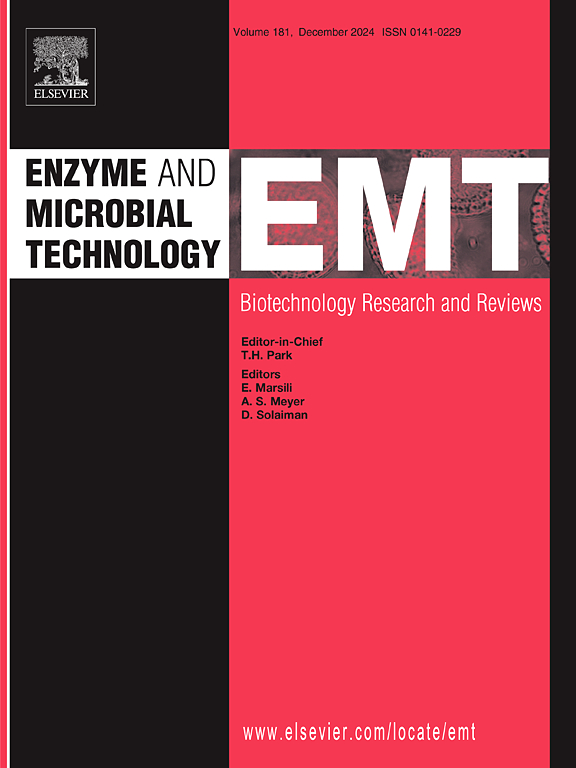Processivity and enzymatic mechanism of a non-modular family 5 endoglucanase from Sporocytophaga sp. CX11 with potential applications in cellulose saccharification
IF 3.7
3区 生物学
Q2 BIOTECHNOLOGY & APPLIED MICROBIOLOGY
引用次数: 0
Abstract
In this study, a novel GH5 processive endoglucanase SmCel5A from Sporocytophaga sp. CX11 was functionally expressed in E. coli. It could rapidly decrease the viscosity of carboxymethyl cellulose (CMC-Na) solution by nearly 50 % within the initial 8 min of incubation and exhibited a significantly high specific activity towards CMC-Na of 9940 U/µmol. SmCel5A could also hydrolyze other cellulosic substrates such as RAC, Avicel, filter paper, β-glucan and the chromogenic substrate pNPC. When hydrolyzing filter paper, about 89.1 % of soluble reducing sugars were generated after 180 min of incubation, and the main products were cellobiose followed by cellotriose and glucose. The processive ratio of SmCel5A increased from 2.32 to 11.22 as the reaction time was extended from 5 min to 180 min, which is significantly higher than those of other known processive endoglucanases. Moreover, SmCel5A could hydrolyze cellodextrins with the degree of polymerization (DP) ≥ 3, but it was not active on cellobiose. In combination reaction with β-glucosidase, the maximum substrate conversion rate reached 73.2 %, showing that the synergistic reaction of the two enzymes could efficiently reduce the accumulation of cellobiose and greatly improve the hydrolysis efficiency of cellulose. The three-dimensional structure of SmCel5A was predicted by AlphaFold2 and showed to feature a classic GH5 family (β/α)8-barrel structure, with a deep substrate-binding cleft formed by the amino acids at the C-terminus. Molecular docking results indicated that when hydrolyzing cellulosic substrates, SmCel5A exhibits a preference for the exo-type mechanism of action over the endo-type mechanism of action.
产自Sporocytophaga sp. CX11的非模块化家族5内切葡聚糖酶的加工过程和酶促机制及其在纤维素糖化中的潜在应用
在本研究中,一种来自Sporocytophaga sp. CX11的新型GH5过程内切葡聚糖酶SmCel5A在大肠杆菌中功能性表达。在8 min的孵育时间内,可使羧甲基纤维素(CMC-Na)溶液的黏度迅速降低近50% %,对CMC-Na的比活性高达9940 U/µmol。SmCel5A还能水解其他纤维素底物,如RAC、Avicel、滤纸、β-葡聚糖和显色底物pNPC。滤纸水解180 min后,可溶还原糖的生成率为89.1% %,主要产物为纤维素二糖,其次为纤维素三糖和葡萄糖。随着反应时间从5 min延长到180 min, SmCel5A的加工比从2.32增加到11.22,显著高于其他已知的加工内切葡聚糖酶。SmCel5A可以水解纤维素糊精,聚合度(DP)≥ 3,但对纤维素二糖没有活性。与β-葡萄糖苷酶联合反应时,底物转化率最高可达73.2 %,说明两种酶的协同反应可有效减少纤维素二糖的积累,大大提高纤维素的水解效率。利用AlphaFold2对SmCel5A的三维结构进行了预测,结果显示SmCel5A具有典型的GH5家族(β/α)8桶结构,其c端氨基酸形成深底物结合间隙。分子对接结果表明,在水解纤维素底物时,SmCel5A表现出对外显型作用机制的偏好,而不是内显型作用机制。
本文章由计算机程序翻译,如有差异,请以英文原文为准。
求助全文
约1分钟内获得全文
求助全文
来源期刊

Enzyme and Microbial Technology
生物-生物工程与应用微生物
CiteScore
7.60
自引率
5.90%
发文量
142
审稿时长
38 days
期刊介绍:
Enzyme and Microbial Technology is an international, peer-reviewed journal publishing original research and reviews, of biotechnological significance and novelty, on basic and applied aspects of the science and technology of processes involving the use of enzymes, micro-organisms, animal cells and plant cells.
We especially encourage submissions on:
Biocatalysis and the use of Directed Evolution in Synthetic Biology and Biotechnology
Biotechnological Production of New Bioactive Molecules, Biomaterials, Biopharmaceuticals, and Biofuels
New Imaging Techniques and Biosensors, especially as applicable to Healthcare and Systems Biology
New Biotechnological Approaches in Genomics, Proteomics and Metabolomics
Metabolic Engineering, Biomolecular Engineering and Nanobiotechnology
Manuscripts which report isolation, purification, immobilization or utilization of organisms or enzymes which are already well-described in the literature are not suitable for publication in EMT, unless their primary purpose is to report significant new findings or approaches which are of broad biotechnological importance. Similarly, manuscripts which report optimization studies on well-established processes are inappropriate. EMT does not accept papers dealing with mathematical modeling unless they report significant, new experimental data.
 求助内容:
求助内容: 应助结果提醒方式:
应助结果提醒方式:


